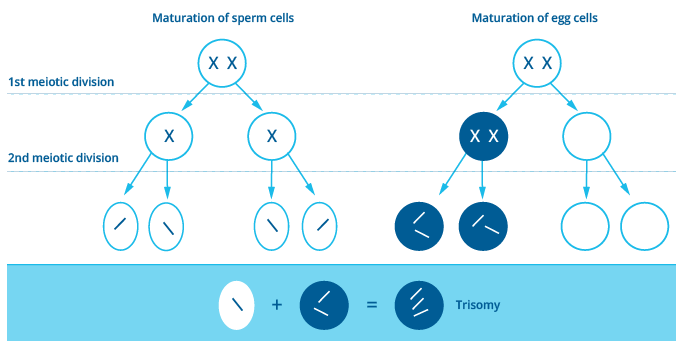

Depending on the chromosomal disorder, the symptoms may vary greatly and affect children’s mental and physical development. Many chromosomal disorders, however, also prevent a pregnancy from occurring or cause early miscarriages. You should obtain comprehensive information and counseling from your doctor regarding your risk and which this may mean for you and your unborn child.
If a certain chromosome is present in the cells of the child three times instead of two times as usual, this is referred to as “trisomy”. The most frequent is trisomy 21, in which chromosome 21 is present three times in the child instead of twice. It causes Down syndrome and occurs approximately once in every 500 to 800 births. The risk of maldistribution of chromosome 21 increases with increasing age of the woman and also of the man. Trisomy 18, also known as Edwards syndrome, occurs much more rarely. It occurs in approximately one out of 5000 newborns. Trisomy 13, known as Patau syndrome, is even rarer. Estimates indicate that it occurs once in every 16,000 births.
If one chromosome is missing from a pair of chromosomes and is thus present only once instead of twice as usual, this is known as “monosomy”. In monosomy X (also known as Turner syndrome or Ullrich-Turner syndrome), the second sex chromosome is missing. It is the only viable monosomy in humans, affects only girls, and occurs approximately once in every 2500 female infants.
In so-called triple X syndrome, three copies of the X chromosome are present. This disorder also affects only girls and occurs approximately once in 1000 female newborns.
In XYY syndrome, which also affects only boys, there is an additional Y chromosome in the cells. This occurs in approximately one out of 1000 male newborns.
These are rare chromosome disorders. For example, in a trisomy 16, the chromosome 16 is present three times instead of twice, and in a monosomy 16 only once instead of twice. The clinical appearance depends on the affected chromosome and may differ from case to case. In some cases, the clinical appearance is normal.
In this syndrome there is a chromosome alteration on the chromosome 22, which can influence the development of the unborn child. It occurs in about one out of 6000 newborns. Your physician will request the determination of this chromosomal disorder, also knows as “DiGeorge syndrome”, only in the case of a concrete medical indication, because this examination is particularly useful in cases of abnormalities on ultrasound, for example during organ screening, which may correlate with a DiGeorge or velo-cardial-facial syndrome (only with the additional form)
In order to improve your understanding, we will first explain the human chromosome set to you:

Schematic figure of the human chromosome set
The genetic material in all cells of the human body is organized in the form of chromosomes. Humans have 23 pairs of chromosomes, for a total of 46 chromosomes. The first 22 pairs are numbered consecutively and are known as “autosomes” (chromosome 1 to chromosome 22). The last two chromosomes determine sex and are known as “gonosomes” or sex chromosomes (X and Y). Girls have two X chromosomes and boys have one X and one Y chromosome. Cells multiply by dividing over and over. Before each cell division, the chromosomes double in order to be evenly divided among the two newly created cells.
Chromosomal disorders are changes to the chromosomes. They develop accidentally due to errors during the maturation of egg and sperm cells (germ cells) or – more rarely – due to errors during cell division during the development of the fertilized egg cell. When cells develop in which the number of chromosomes no longer add up, the cells are described as having numerical chromosome disorders or chromosome maldistribution. For example, a chromosome may be missing, that is, there are only 45 chromosomes in the cell, or there may be one chromosome too many in the cells, that is, the cell has 47 instead of 46 chromosomes.

Schematic figure of a chromosome maldistribution in the first meiotic division
Along with the numerical chromosomal disorders, there are also structural chromosomal disorders which affect the structure of the chromosomes. In these cases, for example, a piece of a chromosome is missing, there is an extra piece or a piece was incorporated incorrectly in the chromosome. A special form of chromosomal disorders are known as “mosaics”. In a mosaic, cells of a tissue or of the entire organism of the embryo contain different genetic information. The PrenaTest® is not able to determine structural changes to chromosomes or mosaics.
[/columns1]